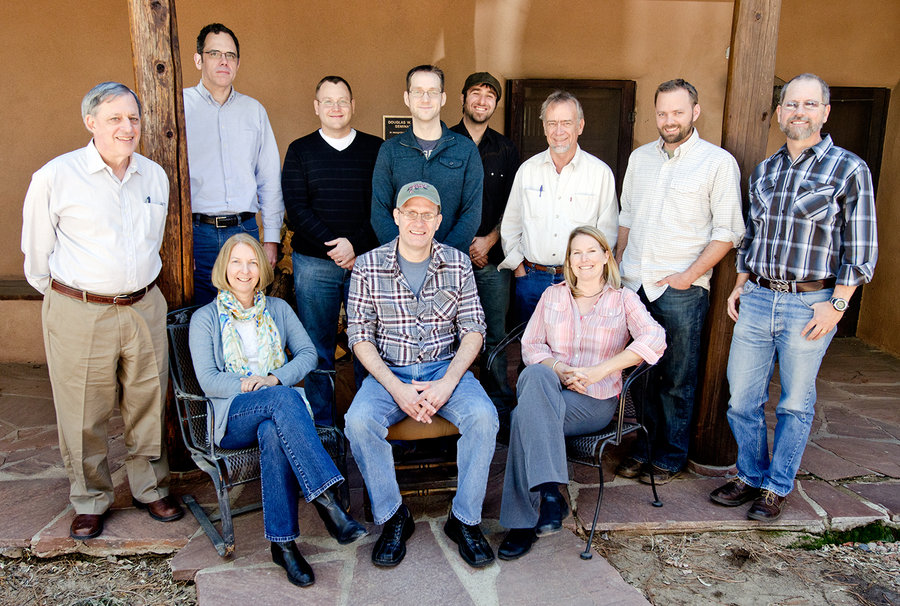
The Dynamics of Social Networks in the Late Prehispanic Southwest
Co-Chaired by Jeffery J. Clark, Deborah Huntley, and Barbara J. Mills
March 13–14, 2012
The Dynamics of Social Networks in the Late Prehispanic Southwest
The Southwest Social Networks (SWSN) research team participated in a productive two-day seminar in an attempt to synthesize the results of an ambitious undertaking. The SWSN Project brings together an interdisciplinary team of scholars who are working to integrate current social network analysis (SNA) method and theory with geographic information systems (GIS) using a large archaeological database. This database consists of all Prehispanic settlements greater than twelve rooms dating from AD 1200 to 1550 for which the team has location, room count, ceramic typological data, geochemically sourced obsidian, or public architectural information. In addition, a number of environmental variables have been added to the GIS portion of the database. Through this integrated approach, the research team is hoping to gain new anthropological insights on settlement interaction and boundaries by focusing on intersite relations at various scales rather than the spatial attributes of the sites themselves.
The research team is currently exploring a variety of questions that are of interest to both archaeologists and social network theorists, including the possibility of looking at network topology to predict migration and coalescence and examining which aspects of network structure are best able to predict future structures and settlement persistence. “One of the advantages of our database is that we can apply SNA at a variety of spatial scales. We can examine intensively studied areas such as the Tonto Basin and San Pedro Valley, where we can see how immigrant enclaves are influencing local trajectories. We can also examine the entire Southwest west of the Continental Divide where large-scale patterns become strikingly apparent over time,” the team reported.
While at SAR, the research team pursued a number of goals: discussion of an overview and status report of the four-year project; presentation and discussion of manuscripts related to the project, six of which were presented at the 2012 Society for American Archaeology annual meetings; and consideration of the topic and regional focus of the next NSF grant related to this project.
Much of the research discussed at the SAR seminar offered fresh methodological approaches of SNA as applied to archaeological data. For example, Brett Hill and Deborah Huntley showed how SNA can be productively tied to GIS to understand the extent to which spatial propinquity correlates with social propinquity. Jeffery Clark, Steven Shackley, and their colleagues built a model to predict obsidian percentages based on distance-decay expectations and then showed which settlements deviated from these expectations. The “deviants” correlated with strong ceramic social networks, suggesting a relationship. Lewis Borck applied a multiscalar approach to address the extent of internal versus external network ties and used this to account for why some regions of the Southwest were depopulated before others.
“The two-day format and informal setting (as well as the cordial staff and delicious food) worked extremely well for our research team.”
—Barbara J. Mills
Employing a two-mode analysis, Randy Haas showed how SNA can effectively be used to look at people-thing relations as well as thing-thing relations, an approach that opens up new interpretive potential for network analyses in archaeology. John Roberts and Ron Breiger explored new ways of assessing the reliability of network analysis through resampling and bootstrapping techniques. Barbara Mills explored how settlement persistence might be predicted by the nodal properties of settlements within the network. Finally, Matthew Peeples looked at “weak” or bridging ties to better understand which sites were brokers in the network at different times. Cumulatively, these papers all showed the value of network analysis for new interpretations of social interaction in the late prehispanic Southwest.
One of the most important themes emerging from the SWSN research project is how transformative late thirteenth-century Ancestral Puebloan migrations were on the social networks in the project area. The magnitude of the changes was much larger than the team had initially thought considering the relatively small number of people who moved. Every analysis showed that after AD 1300, network structures were fundamentally reconfigured at all spatial scales. Furthermore, different areas were central to the network at different times. For the pre–AD 1300 period, for example, a large network of sites that closely interacted in the north was identified by the residents’ use of Cibola White Ware. However, after AD 1350 there emerged a large and tightly integrated network that was linked by the near-exclusive use of Roosevelt Red Ware (also known as Salado polychromes). “Salado polychromes are known for their ideological power, and it was particularly interesting to see how spatially disparate communities became closely ‘networked’ through this ware,” said Mills. “Our research team seminar came at a pivotal time in our project and allowed us to significantly enhance our understanding of an enormous amount of data, discuss each other’s analyses, and identify some overarching themes that we can now take to a wider audience.”
Jeffery J. Clark, Chair
Preservation Archaeologist, Archaeology Southwest
Deborah Huntley, Chair
Preservation Archaeologist, Archaeology Southwest
Barbara J. Mills, Chair
Professor and Director, Department of Anthropology, University of Arizona
Lewis Borck
Ph.D. Candidate, School of Anthropology, University of Arizona
Ronald Breiger
Professor, Department of Sociology, University of Arizona
Aaron Clauset
Assistant Professor, Department of Computer Science, University of Colorado—Boulder
William R. Haas Jr.
Ph.D. Candidate, School of Anthropology, University of Arizona
Brett Hill
Assistant Professor, Department of Sociology & Anthropology, Hendrix College
Matthew Peeples
Postdoctoral Research Associate, School of Anthropology, University of Arizona
John M. Roberts Jr.
Professor, Department of Sociology, University of New Mexico
M. Steven Shackley
Professor Emeritus, Department of Anthropology, University of California—Berkeley
Generous funding provided by the National Science Foundation
